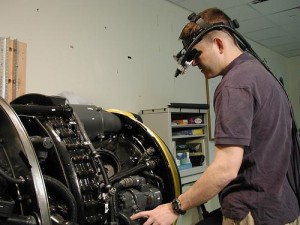
Augmented Reality
Augmented reality (AR) technology seems like a natural fit for personnel performing intricate assembly, maintenance and repair jobs. AR technology is used to annotate physical objects by superimposing physical objects, in real-time, with virtual information from documents, databases and sensors to assist technicians in performing complex tasks. For example, the AR annotation layer could highlight a part to be replaced, identify special tools needed for the task, prescribe detailed work instructions, and display warnings about potentially hazardous materials and activities.
Unlike virtual reality, which replaces the physical world, AR adds information that augments and enhances the real-world experience.
Work on using augmented reality in industrial settings dates back to the 1990s. The renewed interest in applying AR in service and maintenance tasks stems from two converging trends.
First, product companies are recognizing the critical role of service as an integral part of the product lifecycle and the company’s brand. The need to enhance serviced operations and, at the same time, the looming shortage of skilled personnel calls for significant enhancement and enrichment in job aids and information delivery paradigms.
At the same time, technological advancements in device connectivity, cloud computing and display technologies make AR more approachable than ever before.
It’s unfortunate, therefore, that in their haste to pursue and deploy augmented reality, technologists tend to forget the intended users of this technology: who they are, the environment in which they work, and, most importantly, how, exactly, can AR help them perform their tasks more efficiently and safely.
Righty-Tighty Lefty-Loosey
Let’s look at an augmented reality prototype developed for the U.S. Air Force Research Laboratory, which is very typical of most proof of concept demonstrations made by AR technology vendors.
Take a look at the image below. The task facing the technician is to replace the starter motor on a jet engine. The AR layer cleverly points at the starter mount and uses a large bright blue arrow to emphasize that, indeed, this is where the starter motor should be installed.
The AR application even flashes a warning message at the lower left corner of the image that reads:
CAUTION
Shaft misalignment can damage motor. Ensure holes are aligned with studs in starter mount.
You are probably scratching your head and asking yourself: what’s wrong with that?
But if you are a service technician who is qualified and certified to work on jet engines, this information is not only completely unnecessary, but it’s also quite condescending. Surely you don’t need this level of “righty-tighty lefty-loosey” guidance. (For my non-American readers, here is an explanation of the phrase “righty-tighty lefty-loosey“)
This reminds me of the comment made by a senior manager at a manufacturing plant in Europe in response to a similar demonstration: “If any of my line workers said they find this tool useful, they’d be fired.”
For sure, the project for the U.S. Air Force was intended as a feasibility demonstration of AR technology and used mock work instructions. But as impressive as the raw technology is, these demonstrations often leave one with the impression that service technicians are, by and large, an inexperienced and clueless tool-carrying bunch. The technologists behind this type of righty-tighty lefty-loosey demonstrations may not realize that these prototype may lead service technicians and assembly line workers to discredit the system and the engineering team behind it.
Here is another example. The image below shows a technician wearing a head-mounted AR display tethered to some invisible computer system. Under comfortable laboratory conditions this setup does not seem too much of a burden. But in real world conditions, working around rotating parts, scalding heat exchangers and exposed high voltage terminals, the limited peripheral vision and the thick cable are not only uncomfortable, they might be outright dangerous.
Five Good Reasons to Use Augmented Reality
Most service technicians aren’t clueless and helpless. They have the necessary skills and experience to handle most of the service challenges they might face and have little need for snazzy animations or augmented reality devices to perform routine tasks.
This is not to say that service technicians do not need help. They certainly do, especially when we consider the fast increase in the complexity of highly engineered products. The question is: what are the best technologies and methods to deliver this assistance.
Augmented reality hardware will continue to shrink in size and cost. Cumbersome and dangerous cables will give way to near-field wireless communication. But unless we clearly establish the value to the end-user—the service technician—AR is risking remaining an impressive eye candy with very limited use.
System developers need to look far beyond the technology that is used to identify and tag objects and pay more attention to the content presented to the maintenance technician: what information they do need, what are the best to communicate this information to them.
There are certainly clear instances and very good use cases that demonstrate and establish the value of augmented reality in service and maintenance applications. Look for my forthcoming article Five Good Reasons to Use Augmented Reality and How it will Improve Your Service Operations in which I will discuss some of these use cases.
(Images: Augmented Reality for Maintenance and Repair (ARMAR), Columbia University)
(Main photo: Jon Haynes, Flicker )


